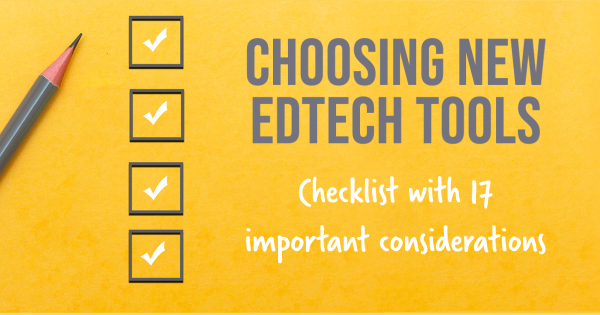17 Important Considerations when Choosing New EdTech Tools
 Dimitri Bongers & Kate Baker —
Dimitri Bongers & Kate Baker —
Choosing the right digital formative assessment tool can significantly impact the classroom experience for both teachers and students. The best EdTech platforms increase student engagement, develop essential skills, streamline grading, and support effective feedback loops.
With so many options available—like BookWidgets, Canva, Genially, Kahoot, Padlet, and emerging AI-powered platforms like SchoolAI, Brisk Teaching, and MagicSchool AI—it can be challenging to identify the best digital formative assessment tools that balance usability, accessibility, cost, and impact on student learning.
This guide isn’t just for teachers or administrators choosing new EdTech platforms and tools. It’s also a useful framework for reflecting on the EdTech tools you already use. Are they still meeting your needs? Could they be doing more to support student growth, engagement, or accessibility?
In a previous blog post, we outlined five key criteria for evaluating classroom technology. In this updated version, we’ve expanded the list to 17 essential questions that can guide your search and help you make more informed, strategic decisions about the technology you bring into your classroom and school. Later in this guide, we’ll also explore how external benchmarks like the ISTE Standards and the EdTech Index can help validate your EdTech choices.
17-Point Checklist for Choosing the Right EdTech Tool
Below is an overview of the 17 things to keep in mind when selecting a new EdTech or digital formative assessment tool. Certain criteria may be more or less important to you—this checklist is designed to help you reflect and prioritize based on your instructional goals.
We also created a handy checklist in BookWidgets. Click on the image to access and use the interactive version:
When you're evaluating a new digital tool, you might not be able to answer all the questions right away. We recommend speaking with colleagues, reading reviews, and testing out the free version. Don’t hesitate to contact the support team—most are happy to assist educators.
1. Does the EdTech tool align with your learning objectives?
 Technology is a means to an end, not the goal itself. Start by identifying your lesson goals and select EdTech tools that directly support those learning outcomes, rather than digital lesson tools that are just flashy or fun.
Technology is a means to an end, not the goal itself. Start by identifying your lesson goals and select EdTech tools that directly support those learning outcomes, rather than digital lesson tools that are just flashy or fun.
2. Is the EdTech tool user-friendly for both teachers and students?
 Digital tools should streamline instruction and workflows, not complicate them. Choose EdTech tools that are intuitive and require minimal onboarding. Research shows students aren't automatically tech-savvy, so usability matters for everyone.
Digital tools should streamline instruction and workflows, not complicate them. Choose EdTech tools that are intuitive and require minimal onboarding. Research shows students aren't automatically tech-savvy, so usability matters for everyone.
Keep in mind that today’s students are often incorrectly labeled as “Digital Natives” suggesting that they possess the essential abilities to master the commonly used digital tools independently. Research has demonstrated that this belief is unfounded, so it's essential to choose tools that are user friendly for the students too.
3. Does the Edtech tool offer multiple interactive activity types?
 Variety increases student engagement and supports different learning goals. Look for digital formative assessment tools that offer a broad range of activity types—quizzes, games, drag-and-drop tasks, multimedia prompts, interactive timelines, and more.
Variety increases student engagement and supports different learning goals. Look for digital formative assessment tools that offer a broad range of activity types—quizzes, games, drag-and-drop tasks, multimedia prompts, interactive timelines, and more.
A tool that includes multiple interactive features is not only more engaging for students, but also more efficient for teachers. Instead of juggling multiple single-purpose apps, an all-in-one EdTech platform can streamline your workflow and reduce the cognitive load for both teachers and students.
💡 Bonus: Consolidating tools also helps your school save money. Rather than paying for multiple separate subscriptions, finding a comprehensive platform with diverse activity types can lower costs and simplify access management. Fewer logins and fewer tools to learn means more time teaching and learning, and less time troubleshooting.
4. Does the EdTech tool include a content library with ready-made resources?
 A searchable library of editable content saves time. Find tools that offer pre-built activities from other educators or a public repository of lesson templates.
A searchable library of editable content saves time. Find tools that offer pre-built activities from other educators or a public repository of lesson templates.
5. Can the EdTech tool’s activities and settings be customized?
 No two classrooms are the same—and neither are your students. Choose EdTech platforms that allow you to customize activities and settings to meet the specific needs of your learners, subjects, and teaching style.
No two classrooms are the same—and neither are your students. Choose EdTech platforms that allow you to customize activities and settings to meet the specific needs of your learners, subjects, and teaching style.
Customizable tools support differentiated instruction by letting teachers adapt content, pacing, and support features based on students’ individual learning needs. Whether you're modifying question formats, adjusting point values, enabling or disabling timers, hiding correct answers, or embedding hints and media, flexibility is key.
The ability to fine-tune instructions, feedback options, and accessibility settings gives teachers greater control over how students interact with the material—allowing you to challenge advanced learners while supporting those who need extra help. A customizable digital assessment tool empowers you to create a learning experience that feels personal, intentional, and inclusive.
6. Does the EdTech tool provide built-in feedback and reporting tools?
 Formative assessment is most effective when feedback is timely, actionable, and accessible. Choose EdTech tools that include built-in reporting dashboards and flexible feedback options—so teachers can monitor student progress and students can understand how they're doing in real time.
Formative assessment is most effective when feedback is timely, actionable, and accessible. Choose EdTech tools that include built-in reporting dashboards and flexible feedback options—so teachers can monitor student progress and students can understand how they're doing in real time.
The best platforms support multi-modal feedback, allowing teachers to respond with written comments, voice recordings, or even annotated images. This variety helps meet the diverse needs of learners and makes feedback more personal and engaging.
Look for tools that offer automated feedback features such as auto-grading, instant score reports, or pre-set explanations for common errors. Automation supports the learning cycle by reducing friction and removing delays—students get immediate input, and teachers save valuable time.
That said, automation should never replace the teacher. A strong feedback system keeps educators in the driver's seat: giving them insight into student performance at a glance, surfacing key areas for intervention, and making it easy to review and respond to student work with just a few clicks.
💡 For students, real-time feedback means they don’t have to wait for a teacher to manually grade every assignment—they can reflect, revise, and grow immediately. For teachers, it means less time spent on rote correction and more time for meaningful teaching.
7. Does the EdTech tool support accessibility and diverse learning needs?
 Accessibility should be built in—not added as an afterthought. Choose EdTech tools that support all learners by offering screen reader compatibility, audio instructions, alternative input options, adjustable font sizes, extra time settings, and other accommodations.
Accessibility should be built in—not added as an afterthought. Choose EdTech tools that support all learners by offering screen reader compatibility, audio instructions, alternative input options, adjustable font sizes, extra time settings, and other accommodations.
A good tool enables teachers to adapt learning experiences without needing separate resources or parallel workflows. This is especially important when differentiating for neurodivergent students, English language learners, or those with IEPs and 504 plans.
8. Does the EdTech tool integrate with your school’s LMS?
 LMS integration simplifies everything—from logins to grading. Whether your school uses Google Classroom, Microsoft Teams, Canvas, Schoology, or another platform, integration ensures a seamless experience for both teachers and students.
LMS integration simplifies everything—from logins to grading. Whether your school uses Google Classroom, Microsoft Teams, Canvas, Schoology, or another platform, integration ensures a seamless experience for both teachers and students.
Look for tools that allow automatic grade syncing, assignment sharing, and feedback delivery within your existing LMS. This keeps everything organized in one place and reduces the number of platforms your team needs to juggle.
9. Can the EdTech tool embed or link to external tools and content?
 Modern classrooms are filled with multimedia. Choose EdTech platforms that support third-party content embedding—like YouTube videos, Google Slides, Desmos, or Geogebra—to enrich lessons and build creative, engaging learning experiences.
Modern classrooms are filled with multimedia. Choose EdTech platforms that support third-party content embedding—like YouTube videos, Google Slides, Desmos, or Geogebra—to enrich lessons and build creative, engaging learning experiences.
This flexibility allows for “app smashing,” where you combine tools to maximize impact. Whether you’re linking to an explainer video or embedding an interactive simulation, integration expands your instructional possibilities.
10. Can the EdTech tool import existing worksheets or PDFs?
 Your existing materials shouldn't go to waste. Select tools that let you import and digitize your current resources—like PDFs, Word documents, or slides—and convert them into interactive, engaging formats.
Your existing materials shouldn't go to waste. Select tools that let you import and digitize your current resources—like PDFs, Word documents, or slides—and convert them into interactive, engaging formats.
This saves time and helps schools make the most of curriculum assets they already have. It's also a great way to bring familiar tasks into a digital space without starting from scratch.
11. Can the EdTech tool export content and student results?
 Even in the cloud, ownership of your data matters. Make sure you can easily export student results, grades, and teacher-created content—whether for backup, analysis, or sharing with colleagues.
Even in the cloud, ownership of your data matters. Make sure you can easily export student results, grades, and teacher-created content—whether for backup, analysis, or sharing with colleagues.
Export functionality also helps during school transitions or audits, giving administrators visibility into student performance and teacher-created materials that may need to be retained or reassigned.
12. Is the EdTech tool available in multiple languages?
 Language shouldn’t be a barrier to technology use. A multilingual interface is essential for younger learners, English language learners, and world language classrooms.
Language shouldn’t be a barrier to technology use. A multilingual interface is essential for younger learners, English language learners, and world language classrooms.
Some tools even let you deliver full lessons—including buttons and instructions—in your target language. This not only supports accessibility but also reinforces vocabulary and digital fluency in context.
13. Does the EdTech tool support diverse pedagogical strategies and dynamic learning environments?
 Effective teaching requires flexibility. The best EdTech platforms adapt to a variety of pedagogical strategies—from project-based learning and flipped classrooms to station rotation, blended learning, and inquiry-driven approaches.
Effective teaching requires flexibility. The best EdTech platforms adapt to a variety of pedagogical strategies—from project-based learning and flipped classrooms to station rotation, blended learning, and inquiry-driven approaches.
Rather than limiting you to one method, a strong digital formative assessment tool should empower you to design lessons that align with your goals and your students’ needs. This flexibility creates a dynamic learning environment where all learners can thrive.
Explore 10 essential pedagogical concepts and how to apply them with EdTech tools
14. Are training and support resources available for the EdTech tool?
 Even the best tools fall flat without strong onboarding. Look for products with robust support systems: searchable help centers, quick-start videos, live chat, and step-by-step tutorials.
Even the best tools fall flat without strong onboarding. Look for products with robust support systems: searchable help centers, quick-start videos, live chat, and step-by-step tutorials.
Professional development webinars, teacher guides, and FAQs or knowledge base articles make a huge difference in how quickly your staff can begin using the tool with confidence.
15. Is there an active educator community around the EdTech tool?
 A great community can be just as valuable as great features. When you choose a tool that’s backed by a thriving educator network—Facebook groups, hashtags, Discord servers—you gain access to real-life ideas, workarounds, and peer support.
A great community can be just as valuable as great features. When you choose a tool that’s backed by a thriving educator network—Facebook groups, hashtags, Discord servers—you gain access to real-life ideas, workarounds, and peer support.
Teacher communities often share ready-made resources, creative use cases, and insider tips that you won’t find in the official documentation.
16. Does the EdTech tool protect teacher and student data appropriately?
 Privacy matters. Before using any digital tool with students, verify how it handles personal data. Look for clear privacy policies, GDPR compliance (for EU), FERPA protections (for U.S. schools), and data minimization practices.
Privacy matters. Before using any digital tool with students, verify how it handles personal data. Look for clear privacy policies, GDPR compliance (for EU), FERPA protections (for U.S. schools), and data minimization practices.
If you can't find this information easily, that’s a red flag. Don't hesitate to contact the company for clarification—especially if your district has strict security protocols.
EU teachers: Ensure the tool stores data within the EU and limits data collection to essential use only.
17. What is the cost and licensing model of the EdTech tool?
 Budget always matters, but price isn't the only factor. While free tools can be appealing, they often come with limits—on features, privacy, or support. Paid tools should offer clear value and a flexible licensing model.
Budget always matters, but price isn't the only factor. While free tools can be appealing, they often come with limits—on features, privacy, or support. Paid tools should offer clear value and a flexible licensing model.
Before making a personal purchase, check if your school or district offers funding, discounts, or site licenses. You may be surprised by what's already available—or what could be added to next year’s budget.
Have you considered BookWidgets?
If you're exploring new digital formative assessment tools—or reflecting on the ones already in your toolkit—consider BookWidgets. Built specifically for teachers, BookWidgets is an all-in-one platform for creating interactive content, monitoring student learning, and giving meaningful feedback.
With over 40 customizable activity types and 36 question formats, plus built-in grading, reporting, and seamless LMS integration, BookWidgets helps you teach, assess, and support your students—all in one place.
How does your favorite EdTech tool stack up against the 17 criteria in this checklist? Better yet—how does BookWidgets score?
👉 Try the interactive checklist and see for yourself. Spoiler: BookWidgets earns top marks across the board.
Have questions about how BookWidgets aligns with your instructional goals? We’re happy to help. Reach out at info@bookwidgets.com. You can also learn more through our free teacher webinars and recordings, or take a closer look at our special, limited-time pricing for schools and teacher groups.
Go Beyond Features: Look for Alignment and Trust
Choosing the right educational tool isn’t just about features—it’s about impact.
One way to ensure that a tool supports high-quality, student-centered learning is by evaluating its alignment with the ISTE Standards. These standards define what effective learning looks like in a digital world—for students, educators, and leaders alike.
Look for tools that have earned the ISTE Seal—a rigorous review process that validates whether a product meets ISTE’s standards for pedagogy and usability.
BookWidgets proudly holds the ISTE Seal for its robust feedback tools, interactivity, and accessibility features. Check out the official findings for how BookWidgets aligns to the ISTE Standards.
🗂️ You can also consult the EdTech Index, a free searchable directory of trusted tools. Explore the BookWidgets listing here to see how it compares across criteria like integrations, accessibility, feedback options, and more.
Wrap Up
We know this checklist covers a lot—but that’s because choosing the right EdTech tools is a big decision. Whether you’re exploring new options or reflecting on the tools you already use, it’s helpful to pause and ask: Is this tool supporting my students and my goals?
Not every tool will check every box—and that’s okay. What matters most is finding a solution that aligns with your teaching style, supports your students’ learning needs, and simplifies your workflow, not complicates it.
We hope this guide helps you make confident, informed decisions about the digital tools in your classroom. If you’re curious to explore what BookWidgets can do, you can learn more through our free teacher webinars and recordings, or take a closer look at our special, limited-time pricing for schools and teacher groups.
We also invite you to connect with fellow educators by joining our Facebook community, following BookWidgets on LinkedIn, or finding us on BlueSky.
And we’d love to hear from you:
Which EdTech tools are in your teacher’s toolkit—and why?
Join the conversation on X (Twitter) @ibookwidgets, in our Facebook group, or on LinkedIn.





